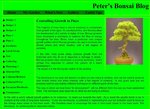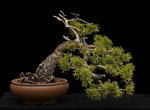Not meaning to high-jack the thread but I just bought three Jack Pines 'Schoodik" variety. They were collected in Main. Anything from anyone on these?
Jack Pine 'Schoodik' or more correctly Pinus banksiana 'Schoodic' The correct spelling ends with a 'c', rather than 'k'.
Labeled with a cultivar name means these trees could NOT BE COLLECTED, this is a registered, named cultivar. It is widely available in the rock garden landscape nursery trade. Only a single plant was originally found, all resulting plants are the result of propagation by grafting. It was registered in 1979, I don't know if it is a witches broom or a genetic dwarf, but it is a prostrate - low growing - dwarf form of jack pine with fairly short needles. Your 3 plants of 'Schoodic' have got to be 3 plants propagated by grafting. Somewhere on the trunks, you should see the scar of the graft union. They were most likely grafted onto Scots pine understock. So the roots are scots pine, sylvestris, and the growth is a particular cultivar of jack pine, banksiana 'Schoodic'.
If they actually were raised from seed, acquired from a P. banksiana 'Schoodic' , because each seedling is genetically different than its parent, the seedlings can not be called 'Schoodic' and there is no guarantee that these seedlings would retain the shorter needles and prostrate growth habit of the parent 'Schoodic'. Seedlings can not be listed as 'Schoodic', but they can be described as seedlings from 'Schoodic'. If they are from seed you could give each seedling a unique cultivar name as each will have unique genetics. It is a pain in the behind to formally register the cultivar names, but it can be done if you plan on propagating the seedlings. If indeed you have seedlings.
So, are your 3 jack pines grafted 'Schoodic' ? or are your 3 jack pines seedlings without a cultivar name, but who's parentage includes 'Schoodic' for at least 50% of its genetics?
Not trying to be a nit picking detail orientated jerk, but it is helpful for you to understand what you are growing, and especially through Ebay, sellers are often sloppy about correctly informing their customers as to what they are buying.


